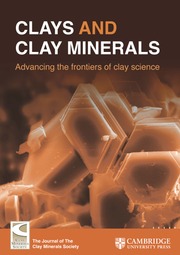Article contents
Binding of DNA to Natural Sepiolite: Applications in Biotechnology and Perspectives
Published online by Cambridge University Press: 01 January 2024
Abstract
DNA manipulation is crucial for many biotechnological prospects and for medical applications such as gene therapy. This requires the amplification and extraction of DNA from bacteria and the transfer of these DNA molecules into cells, including bacterial and mammalian cells. The capacity of the natural magnesium silicate clay mineral sepiolite to bind to DNA makes it a potentially useful tool for biotechnological/medical strategies. In addition, sepiolite is inexpensive and classified as non-toxic and non-carcinogenic. This review will first describe the physicochemical interactions between sepiolite and DNA. Then, the leverage of sepiolite/DNA interactions for DNA extraction from bacteria, to optimize DNA transfer into bacteria and DNA transfection into mammalian cells, are presented. Finally, the putative toxicity of sepiolite and its advantages and perspectives for future prospects, such as the improvement of immunotherapy, are also discussed.
Keywords
- Type
- Article
- Information
- Clays and Clay Minerals , Volume 69 , Issue 5: Clay Minerals in Health Applications , October 2021 , pp. 633 - 640
- Copyright
- Copyright © The Clay Minerals Society 2021
Footnotes
Sandrine Ragu and Olivier Piétrement contributed equally to the writing of this paper
This paper belongs to a special issue on ‘Clay Minerals in Health Applications’
References
- 6
- Cited by


